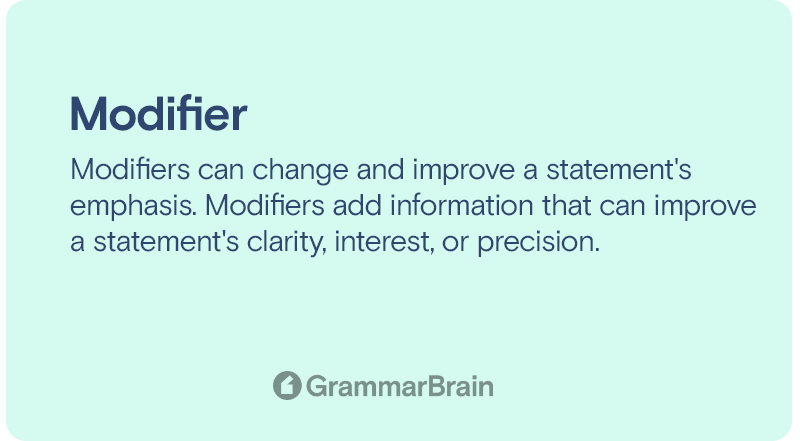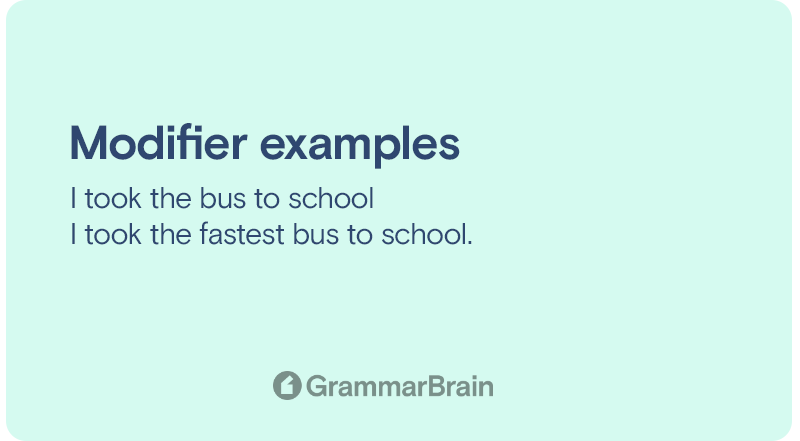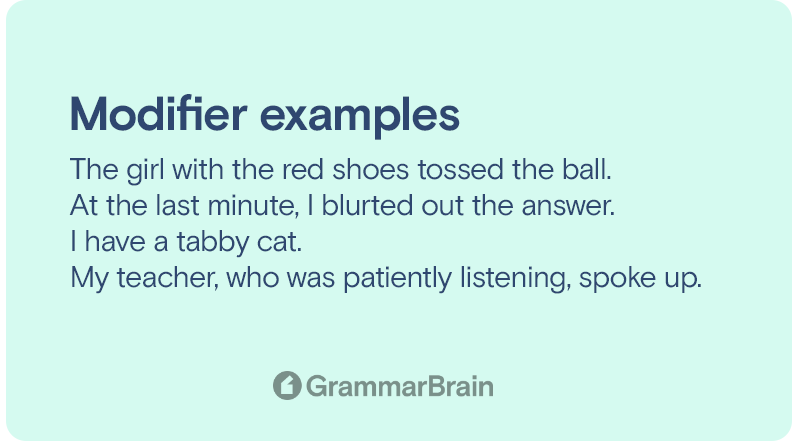What is a modifier? Have you ever wondered what those words are that aid you in telling your audience what, how and when something happened? Words that do these are called modifiers. They are words that can modify other nearby words.
Let’s take a deeper look at modifiers and how they can be used appropriately.

What is a modifier?
Many sentences in the English language call for the use of a modifier. There are 4 main types of modifiers that can get found in common sentences.
Definition
A modifier is a phrase or word(s) that changes the meaning of some other component. It’s usually an optional clause. Modifiers give you additional information about the subject that we are talking about.
Merriam-Webster defines a modifier as a phrase or a word that specifies another word. They can be adjectives, that is, modifiers that change the meaning of a noun. They can also be adverbs or modifiers that alter a verb’s meaning.
The grammatical word (modifier) began getting used in the English language (with the same meaning) as early as 1583. Its etymology stems from the old French word modifier and the Latin word “modificare,” both of which meant to limit or change something.

Types of modifiers
There are different types of modifiers that you can use in a sentence. These are:
- Adjective Phrases
- Adverbial Phrases
- Prepositional Phrases
- Limiting Modifiers
As the name suggests, these modifiers can replace adjectives, adverbs, or prepositions.
What does a modifier do?
Modifiers can change and improve a statement’s emphasis. Modifiers add information that can improve a statement’s clarity, interest, or precision. They signify how a particular scenario affects a function or operation. Although, it does not alter the sentence’s main description.
The placement of a modifier should be near to the subject it describes. Making the modifier more simple to understand. If the modifier is at the start of a sentence, then it should modify the main subject of that statement.
It’s important that the subject a modifier is altering be present in that sentence. Following these simple grammar rules can help to make a statement easier to comprehend.

Modifier Examples
Consider the following sentences:
- I took the bus to school
- I took the fastest bus to school.
The second sentence gives us more information. It tells us that the bus was fast. Modifiers help in making a sentence more descriptive. They can clarify a statement’s context, make it more precise, or add to its overall appeal.
As we can see, the reader gets more context from the second sentence. These elements can act as anticipation, explanation, and a way to distinguish this from another remark or grab the audience’s interest.
Examples of modifiers are:
- double
- red
- quickest
- somewhat fast
- underneath the table
- with happiness in her eyes
Some modifiers can be single words, while others can be phrases or clauses. Let’s see these type of modifiers in sentences:
- The girl with the red shoes tossed the ball.
- At the last minute, I blurted out the answer.
- I have a tabby cat.
- My teacher, who was patiently listening, spoke up.
How are modifiers structured?
Modifiers can be kept anywhere in a sentence, but they are often found near a noun. They can be kept before the main subject or after it. For example:
- She ordered noodles without sauce!
- She has a golden dog.
Otherwise, they are used with verbs or adjectives to give us further information. For example:
- She picked out a bright yellow dress.
Putting modifiers in these positions makes it far easier for the reader. What do you think happens if they are put in other positions of a sentence? They create misplaced modifiers, which we will see in detail later.
What is a Squinting Modifier?
Squinting modifiers are confusing. As they can refer to the subject before them.
At the same time, they can apply to the subject that comes after.
This creates an ambiguity in the sentence.
This might confuse the reader regarding what the modifier is referring to. Avoid confusion by switching the modifier around the sentence.
Squinting modifier examples
Some examples of squinting modifiers are:
- I hoped once the appointment was over I could meet Louisa.
- The teachers who attended the meeting sometimes got cake.
We have to move the modifier to fix these sentences and make them more precise. For example:
- Once the appointment was over, I hoped I could meet Louisa.
- Sometimes, the teachers who attended the meeting got cake.
What is a Dangling Modifier?
A modifier that gives additional information but does not change any specific subject in a sentence is known as a dangling modifier. Even if you understand their meaning, you might find reading these types of modifiers awkward.
This is because the extra information they give seems random, as they are not about a given subject. They are not changing the subject or a noun. To avoid these mistakes, add a subject to the sentence.
Dangling modifier examples
Some sentences with dangling modifiers are:
- After watching the movie, the book was great.
- Before driving, a cat played on the lawn.
You can fix these dangling modifiers by:
- After watching the movie, she thought the book was great.
- Before driving, I watched a cat playing on the lawn.
Here, we have added a subject to make the sentence more cohesive.
What is a Misplaced Modifier?
Usually, modifiers are kept near the noun or the main subject of a sentence. If they are put in other positions, they can be confusing, and these modifiers are called misplaced modifiers.
Misplaced modifier examples
Look at the following sentences:
- My mom got a car for my brother called Bruno.
- She built a house for her brother out of bricks.
Here, is Bruno the car or the brother? Is the house built out of bricks, or did the brother live inside bricks previously? The sentences can seem confusing. A better phrasing would be:
- My mom got a car called Bruno for my brother.
- She built a house out of bricks for her brother.
These sentences are more clear now. Both squinting and dangling modifiers are versions of misplaced modifiers.
What is the difference between adjectival and adverbial modifiers?
There are several distinct categories of modifiers that can be used in English. Find out everything about adverb and adjective modifiers in the following guide.
Adjective modifiers and their uses
Nouns and pronouns can only be modified by adjectives. They are modifying in the sense that they provide answers to certain queries in regard to the nouns that they are modifying.
Answering inquiries such as “what sort,” “which one,” “how many,” and “how much” are the responsibilities of adjective modifiers.
Examples:
1. James is holding a cute baby.
This sentence answers what kind of baby is James holding. He is holding a cute baby.
2. That baby is adorable.
This sentence answers which baby is adorable. It is that baby who is adorable.
3. Selena has four dogs.
The sentence answers how many dogs does Selena have. She has four dogs.
4. Charlie has bought enough bread to last a week.
This sentence answers how much bread has been bought by Charlie. He has bought enough bread to last a week.
Adverb modifiers
Verbs, adjectives, and even other adverbs can be modified by adverbs. They are modifying in the sense that they provide answers to certain queries in regard to the nouns that they are modifying.
When, where, how frequently, and how much are some of the queries that may be answered by adverbial modifiers.
Examples:
1. Charlie is coming home next week.
This sentence answers when is Charlie coming. He is coming next week.
2. The dog created a mess everywhere.
This sentence answers where did the dog create a mess. It created a mess everywhere.
3. Charlie goes to the museum every day.
The sentence answers how often does Charlie go to the museum. He goes there every day.
Why are modifiers considered to be so important?
The use of appropriate modifiers is essential to the English language. Without them, our reading and writing would not be nearly as productive or successful as it already is. In addition, our phrases would be quite uninteresting to read.
The following phrases are an attempt to describe the events of a typical day without using any modifiers:
- James woke up.
- James showered.
- James ate.
- James dressed up.
- James drove.
- James worked.
- James drank.
- James bought.
- James slept.
That is neither intriguing nor engaging in the least!
The following is an excerpt from that same schedule with some modifications:
Before getting dressed for work, James got up early and showered. Then he continued on with his daily routine. He then got in his car and headed to work, where he had a very active day. After a jam-packed day, he took some time out to grab a cup of coffee before heading back home.
Modifiers clearly contribute to the improvement of language and have an impact on the way people interact on a daily basis.
Conclusion
Modifiers can help in converting a piece of writing from boring to engaging.
Understanding the various modifiers and their use can help you write more interesting sentences.
Modifiers are almost always found in common English phrases, sentence, literature, and poems.
FAQs
1. What part of a sentence do modifiers go in?
The term that the modifier specifies must be near it. Various interpretations can result from where the modifier is placed. To make a sentence easy to understand, it’s recommended to keep modifiers at the start of a statement.
2. What are some single-word modifiers?
Standard adjectives like “little,” “pretty,” or “expensive” are examples of single-word modifiers.
3. Do adjectives count as modifiers?
Yes, adjectives do count as modifiers. Both adverbs and adjectives are two popular forms of modifiers. Adjectives and adverbs can all act as modifiers. But not all modifiers are adjectives and adverbs.
4. How do modifiers work?
The function of a modifier is to insert descriptive language into a phrase, either immediately before or immediately after the words that it is modifying. As an illustration, the following is one example of how the word alone can change a sentence:
- They played once.
- They only played once.
5. What are the many types of modifications that are available?
The following are some examples of distinct types of modifiers:
- Phrases that use adjectives
- Adjective clauses
- Adjectives
- Adverbs
- Phrases used as adverbs
- Adverbial phrases
- Limiting adjectives and adverbs
- Modifiers in the wrong places
- Phrases that use prepositions
Sources
- Modifiers: Adjectives and Adverbs
- What is a Modifier? Definition, Examples of Modifiers
- Modifiers
- Type Modifiers
- What Is a Modifier in Grammar?
- What Are Modifiers? (with Examples)
- Modifiers: Definition, Types & Examples
- What Are Modifiers? How to Use Them Correctly, with Examples
Inside this article
Fact checked:
Content is rigorously reviewed by a team of qualified and experienced fact checkers. Fact checkers review articles for factual accuracy, relevance, and timeliness. Learn more.
Core lessons
Glossary
- Abstract Noun
- Accusative Case
- Anecdote
- Antonym
- Active Sentence
- Adverb
- Adjective
- Allegory
- Alliteration
- Adjective Clause
- Adjective Phrase
- Ampersand
- Anastrophe
- Adverbial Clause
- Appositive Phrase
- Clause
- Compound Adjective
- Complex Sentence
- Compound Words
- Compound Predicate
- Common Noun
- Comparative Adjective
- Comparative and Superlative
- Compound Noun
- Compound Subject
- Compound Sentence
- Copular Verb
- Collective Noun
- Colloquialism
- Conciseness
- Consonance
- Conditional
- Concrete Noun
- Conjunction
- Conjugation
- Conditional Sentence
- Comma Splice
- Correlative Conjunction
- Coordinating Conjunction
- Coordinate Adjective
- Cumulative Adjective
- Dative Case
- Determiner
- Declarative Sentence
- Declarative Statement
- Direct Object Pronoun
- Direct Object
- Diction
- Diphthong
- Dangling Modifier
- Demonstrative Pronoun
- Demonstrative Adjective
- Direct Characterization
- Definite Article
- Doublespeak
- False Dilemma Fallacy
- Future Perfect Progressive
- Future Simple
- Future Perfect Continuous
- Future Perfect
- First Conditional
- Irregular Adjective
- Irregular Verb
- Imperative Sentence
- Indefinite Article
- Intransitive Verb
- Introductory Phrase
- Indefinite Pronoun
- Indirect Characterization
- Interrogative Sentence
- Intensive Pronoun
- Inanimate Object
- Indefinite Tense
- Infinitive Phrase
- Interjection
- Intensifier
- Infinitive
- Indicative Mood
- Participle
- Parallelism
- Prepositional Phrase
- Past Simple Tense
- Past Continuous Tense
- Past Perfect Tense
- Past Progressive Tense
- Present Simple Tense
- Present Perfect Tense
- Personal Pronoun
- Personification
- Persuasive Writing
- Parallel Structure
- Phrasal Verb
- Predicate Adjective
- Predicate Nominative
- Phonetic Language
- Plural Noun
- Punctuation
- Punctuation Marks
- Preposition
- Preposition of Place
- Parts of Speech
- Possessive Adjective
- Possessive Determiner
- Possessive Case
- Possessive Noun
- Proper Adjective
- Proper Noun
- Present Participle
- Prefix
- Predicate



